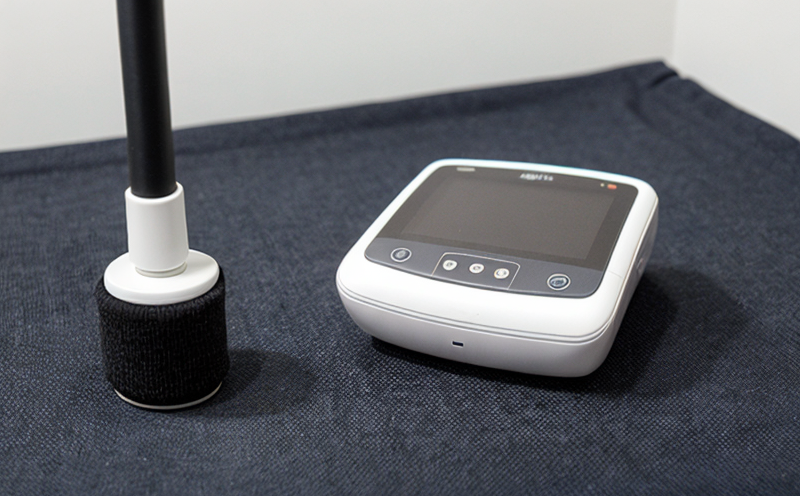DIN 54370 Electrical conductivity of technical textiles
The DIN 54370 standard is specifically designed to measure the electrical conductivity of technical textiles. This test is crucial for industries that rely on conductive textiles, such as aerospace, automotive, and electronics manufacturing. The primary purpose of this test is to ensure that textiles meet specified electrical performance requirements, which are critical for safety and functionality in various applications.
Technical textiles, defined by their multifunctional properties beyond basic strength, often incorporate metallic fibers or conductive yarns to achieve specific functionalities such as thermal management, static dissipation, and electromagnetic shielding. The measurement of electrical conductivity is paramount for these applications because it directly affects the performance and reliability of the textile.
The test procedure outlined in DIN 54370 involves clamping a specimen between two electrodes and measuring the current flow through it while applying a defined voltage. This setup allows for accurate determination of the resistivity or conductivity of the sample, which is essential for ensuring that the product meets the specified performance criteria.
During specimen preparation, it's important to ensure homogeneity across samples by cutting them into standard-sized pieces and preparing them in a consistent manner. The choice of electrodes can also influence the results, so care must be taken to select appropriate materials that do not introduce additional resistance or alter the measured values.
The acceptance criteria for this test are based on the expected performance characteristics of the textile in question. For instance, if the application involves static dissipation, the conductivity value should fall within a specified range to ensure effective grounding and safety. Understanding these requirements upfront helps in selecting the right samples and preparing them accurately for testing.
Performing this test ensures compliance with international standards and regulatory requirements, which is essential for manufacturers operating globally. Compliance not only protects the consumer but also enhances brand reputation and market trust. Moreover, the accurate measurement of electrical conductivity can lead to process improvements and innovation in product design.
In summary, DIN 54370 provides a robust framework for assessing the electrical properties of technical textiles, ensuring that they meet critical performance criteria across various industries. This standard is particularly important for applications where safety, reliability, and functionality are paramount.
Eurolab Advantages
At Eurolab, we offer unparalleled expertise in conducting DIN 54370 tests with precision and accuracy. Our state-of-the-art facilities ensure that every test is performed under controlled conditions, providing reliable results that meet international standards.
- Accurate Instrumentation: We use high-precision equipment to measure electrical conductivity, ensuring that the results are both accurate and repeatable.
- Experienced Personnel: Our team of skilled professionals is well-trained in interpreting complex data from DIN 54370 tests and translating these into actionable insights for our clients.
- Comprehensive Reporting: We provide detailed reports that not only include the test results but also offer recommendations for process improvements and areas of potential enhancement.
- Global Recognition: Our laboratory is accredited to conduct DIN 54370 tests, ensuring compliance with international standards recognized worldwide.
We pride ourselves on our commitment to excellence in every aspect of textile testing. By choosing Eurolab for your DIN 54370 test requirements, you can be assured of high-quality results that meet and exceed industry expectations.
Why Choose This Test
- Ensures Safety: Measuring electrical conductivity is essential for ensuring the safety of products in environments where static electricity or electromagnetic interference could pose risks.
- Promotes Compliance: By adhering to DIN 54370 standards, manufacturers can ensure their products meet international regulations and gain a competitive edge in the global market.
- Increases Product Reliability: Accurate conductivity measurements help guarantee that technical textiles perform reliably under various conditions, enhancing overall product quality.
- Fosters Innovation: Understanding electrical properties can lead to new applications and improvements in existing products, driving innovation within the textile industry.
The test is particularly beneficial for industries such as aerospace, automotive, and electronics where safety, performance, and reliability are critical. By ensuring that technical textiles meet specified conductivity levels, manufacturers can enhance product functionality and meet stringent regulatory requirements.
Use Cases and Application Examples
The DIN 54370 test is widely used in industries where the electrical properties of technical textiles are crucial for performance and safety. Here are some specific applications:
- Aerospace: Conductive textiles can be used in aircraft interiors to dissipate static electricity, enhancing passenger comfort and safety.
- Automotive: Textiles with embedded conductive fibers can be used for thermal management or as part of the vehicle's electrical system.
- Electronics Manufacturing: Conductive textiles are used in circuit boards and other electronic components to improve signal integrity and reduce interference.
In each case, the accurate measurement of electrical conductivity is essential. It ensures that the textile functions as intended, providing reliable performance under various conditions. This test helps manufacturers meet stringent regulatory requirements and enhances product safety and reliability.





